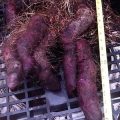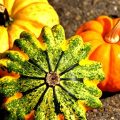Ubi is grown primarily for its roots or tubers. Harvested ubi tubers can be eaten boiled, baked, roasted, flakes, chips, and processed into powder for various recipes. Mashed ubi is used in making ubi tarts, ubi fillings, pastillas, yemas, ubi flan, and other dessert. Here are some ubi recipes you can make at home.

Ube Halaya
Ingredients:
3 cups mashed ubi or powdered ubi
1 cup evaporated milk
1 tbsp margarine
1/2 cup wheat flour
2 cups sugar
Procedure:
1. Mixed three cups of masked ubi, or powdered ubi with water.
2. Blend the smashed ubi or powdered ubi with all the ingredients.
3. Cook over low heat, add lemon constantly for 25 minutes.
4. add lemon rind, before removing from heat.
5. Place in small bottles and let cool before sealing tightly.
Pastillas de Ubi
Ingredients:
4 cups ground boiled ubi
3 cups sugar
1 big can evaporated milk
Preparation:
1. Mix the ingredients together and cook in a copper vat (tacho) over a moderate fire;
2. Stir constantly to avoid burning;
3. When the ubi thickens and doesn’t stick to the vat, remove from the fire and pour on a sugared board;
4. Roll the pastillas to one-and-a-half centimeters thick and then cut into desired pieces;
5. Arrange the pieces on a cooked sheet and place in the oven at 200°F for 20 minutes.
Puto de Ubi
Ingredients:
2 cups rice
1 1/2 cups water
1 cup sugar
2 cups mashed ubi
1/4 cup rich coconut milk
4 tbsp. baking powder
Procedure:
1. Washed cleaned rice and soak in water overnight.
2. Grind the rice finely using a native stone grinder, a corn meal grinder, or a meat grinder.
3. Boil the ubi in enough water until cooked and soft.
4. Peel the ubi and mash finely.
5. Add sugar and mash the ubi with ground rice, blend well and pass through a stainer to remove lumps.
6. Add coconut milk and baking powder. Mix thoroughly.
7. Pour the mixture into puto molds or spoon it into individual molds, filling each two-thirds full.
8. Set the molds in a steamer over boiling water. Cover the steamer.
9. Puto is cooked when a toothpick comes out clean and dry when inserted in the center of the molds.
10. Remove from the molds and serve with grated coconut.
Yam Flour
1. Wash the tubers thoroughly in running water.
2. Cut into slices 2 inches (5 cm) thick, and cook for 20 to 25 minutes or until soft.
3. Peel and mash into pulp, then spread out thinly, about .75 inches (2 cm) thick.
4. Dry for 6 to 8 hours at a temperature of 122-158°F (50-70°C) until the pulp is only about 10 per cent moist.
5. Ground the dried product finely and sift before packing in polyethylene sacks.
Mashed Ubi
1. For marketable mashed ubi, select good quality tubers.
2. Wash them to remove adhering dirt and divide into half kilo sections.
3. Cook by steaming or boiling for 30 to 45 minutes.
4. Afterwards, peel before shredding or mashing.
5. Place the processed ubi in a plastic bag, leaving just enough space to seal the bag.
6. Store the packed mashed ubi in a freezer for not longer than 6 to 8 months.
Sources: da.gov.ph, mis.dost.gov.ph






Its importance? Pastillas de ube is important because we give a new look, taste and value to a simple ube. Making it one of the many sought-after pasalubong for our loved ones.
what is the important of pastillas de ube i need your answer immediately plzz………
im starting implementing my business plan my product is all about ube, can i used a real ube in mAking pastillas de ube rather than ube powder because ube powder is not available in our province. i need a immediate response thank you
thank you so much. yummy and delicious recipes.